Homemade Dog Food for Pancreatitis: 5 Effective Recipes
Finding appropriate nutrition becomes a critical concern when your beloved canine companion is diagnosed with pancreatitis. Creating homemade dog food for pancreatitis can be an effective way to manage this serious condition while ensuring your pet receives proper nutrition. This comprehensive guide explores the dietary needs of dogs with pancreatitis, provides essential nutritional guidelines, and introduces five specially formulated recipes that can help your furry friend recover and thrive.
Table of Contents
Understanding Canine Pancreatitis: A Foundation for Better Feeding
Before diving into the specific diet for dogs with pancreatitis, it’s essential to understand the condition itself. Pancreatitis is a painful condition caused by the inflammation of the pancreas, the organ that produces digestive enzymes and insulin. When inflamed, the pancreas may begin to digest itself and surrounding tissues due to the premature activation of these enzymes. This can be a challenging experience, so seeking medical help is important for managing symptoms and finding relief.
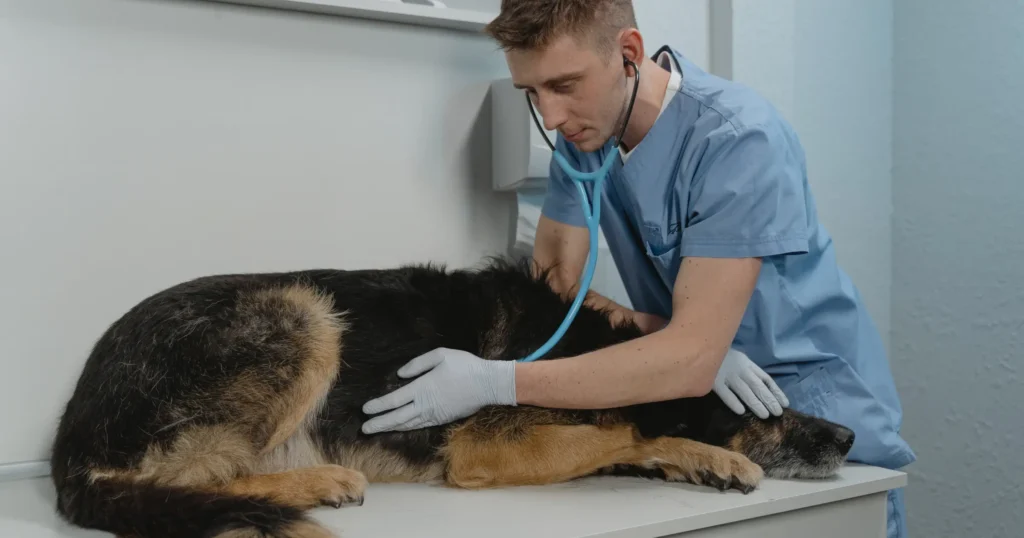
Types of Pancreatitis in Dogs
Pancreatitis typically occurs in two forms:
Acute Pancreatitis:
- Sudden onset of symptoms
- Often severe and potentially life-threatening
- May resolve with proper treatment
- Can lead to chronic pancreatitis if recurrent or severe
Chronic Pancreatitis:
- Ongoing, persistent inflammation
- May present with milder but recurring symptoms
- Requires long-term management
- Can cause permanent damage to the pancreas
Both forms require careful attention to diet, making homemade food for dogs with pancreatitis an important consideration for pet owners.
Common Causes of Pancreatitis
Understanding what triggers pancreatitis can help prevent recurrence:
- High-fat diets: The most common dietary trigger
- Obesity: Increases risk significantly
- Certain medications: Some drugs can contribute to inflammation
- Genetic predisposition: Some breeds are more susceptible
- Previous episodes: Dogs with a history of pancreatitis are at higher risk for recurrence
- Endocrine disorders: Conditions like diabetes or hypothyroidism
- Physical trauma: Injury to the abdomen
- Toxin exposure: Certain poisons can damage the pancreas
Recognizing Symptoms
Early recognition of symptoms helps ensure prompt treatment:
- Vomiting
- Abdominal pain (hunched posture, “prayer position”)
- Loss of appetite
- Lethargy
- Diarrhea
- Fever
- Dehydration
- Increased heart rate
- In severe cases, shock or collapse
If your dog exhibits these symptoms, veterinary care is essential before implementing any homemade dog food for pancreatitis.
Dietary Management: The Foundation of Pancreatitis Treatment
Diet plays a crucial role in both treating active pancreatitis and preventing recurrence. Understanding what to feed a dog with pancreatitis is fundamental to managing this condition effectively.
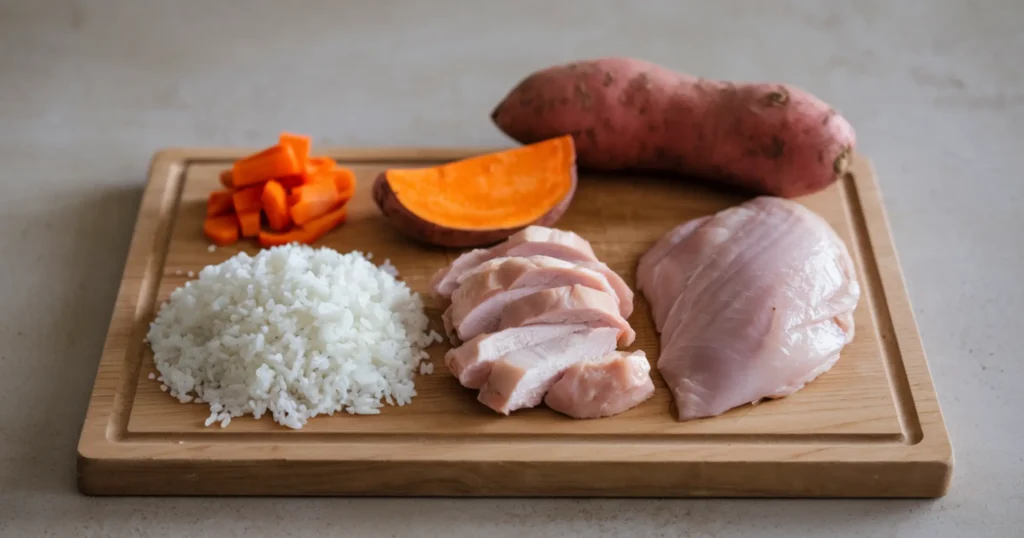
Why Diet Matters in Pancreatitis
The pancreas is directly involved in digestion, particularly of fats. When a dog consumes high-fat foods, the pancreas must produce more enzymes to break down these fats. For dogs with pancreatitis, this increased demand can trigger or worsen inflammation.
A properly formulated diet for dogs with pancreatitis helps by:
- Reducing strain on the pancreas
- Allowing inflammation to subside
- Preventing the recurrence of acute episodes
- Managing symptoms in chronic cases
- Supporting overall health and recovery
Core Principles of Feeding Dogs with Pancreatitis
When preparing homemade food for dogs with pancreatitis, follow these essential principles:
1. Low-Fat Content
The single most important dietary modification for pancreatitis is fat restriction. A low-fat diet reduces the workload on the pancreas and minimizes stimulation of digestive enzyme production.
- For acute pancreatitis: Very low fat during recovery (about 10% of calories from fat)
- For chronic management: Moderately low fat (about 15-20% of calories from fat)
- Aim for: Lean proteins and low-fat cooking methods
Our lean chicken recipe offers an excellent starting point for dogs recovering from acute pancreatitis.
2. Highly Digestible Ingredients
Easily digestible ingredients reduce stress on the digestive system and allow for better nutrient absorption with minimal digestive effort.
- Preferred carbohydrates: White rice, sweet potatoes, regular potatoes, pumpkin
- Protein sources: Lean chicken, turkey, white fish, low-fat cottage cheese
- Cooking methods: Boiling, steaming, or baking without added fats
For particularly sensitive dogs, a simple white fish and sweet potato combination provides excellent digestibility.
3. Moderate Protein
While protein is essential, extremely high protein diets may stimulate the pancreas unnecessarily.
- Recommended: Moderate, high-quality protein from lean sources (25-30% of calories)
- Concentrate on low-fat protein sources such as skinless chicken breast or white fish.
- Avoid: Fatty meats, organ meats, and high-fat dairy
Our turkey and pumpkin preparation provides an ideal protein balance for maintenance.
4. Frequent Small Meals
Feeding schedule and portion control are just as important as the homemade dog food for pancreatitis ingredients themselves.
- Frequency: 3-6 small meals daily rather than 1-2 large meals
- Consistency: Regular feeding times to establish a routine
- Quantity: Carefully measured portions to prevent overfeeding
5. Gradual Transitions
Any dietary change, even to a more appropriate diet for dogs with pancreatitis, should be introduced gradually.
- Initial transition: Mix increasing amounts of new food with previous diet over 7-10 days
- Between recipes: When switching between different homemade formulations, transition gradually
A gentle, vegetarian option can be particularly useful during transitions or flare-ups.
Foods to Absolutely Avoid in Pancreatitis Diets
When preparing homemade dog food for pancreatitis, certain ingredients must be completely eliminated:
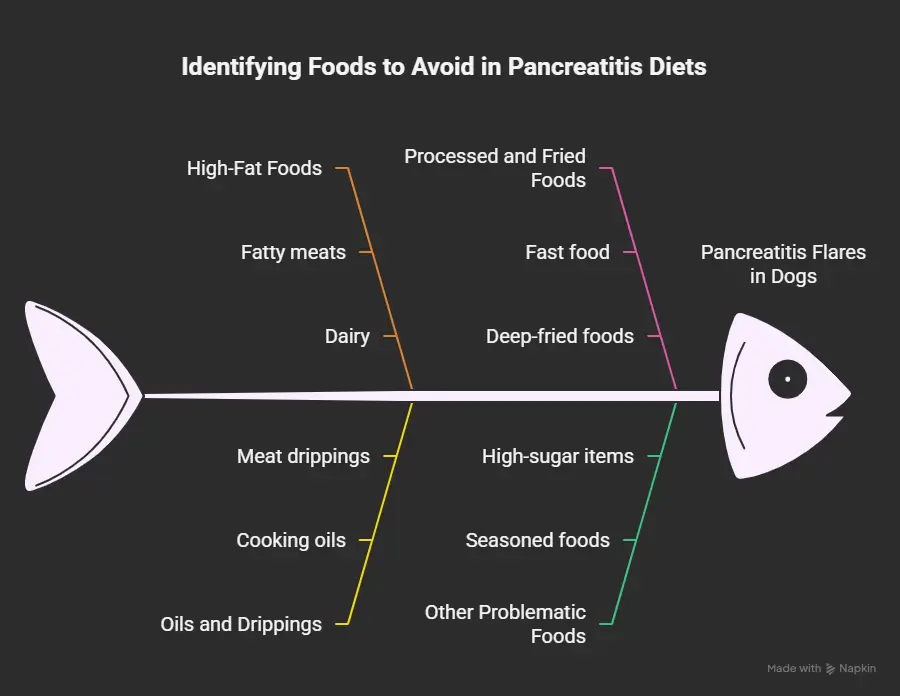
High-Fat Foods
These pose the greatest risk for triggering pancreatitis flares:
- Fatty meats: Bacon, sausage, untrimmed beef, dark meat poultry with skin
- Dairy: Full-fat cheese, cream, butter, ice cream
- Oils and drippings: Cooking oils, meat drippings, gravy
- Nuts: All varieties, especially macadamia nuts
- Fast food and processed meats: Burgers, hot dogs, deli meats
- Deep-fried foods: Any fried items, even seemingly healthy ingredients
Other Problematic Foods
Beyond fat content, some foods pose other risks:
- Seasoned foods: Garlic, onions, heavy spices (toxic to dogs and may irritate the digestive tract)
- High-sugar items: Cookies, candy, sweetened foods
- Human “treats”: Table scraps, particularly from rich or seasoned foods
- Processed commercial treats: Many contain hidden fats and preservatives
Essential Ingredients for Healing Homemade Recipes
When creating homemade food for dogs with pancreatitis, certain ingredients stand out for their health benefits and appropriateness.
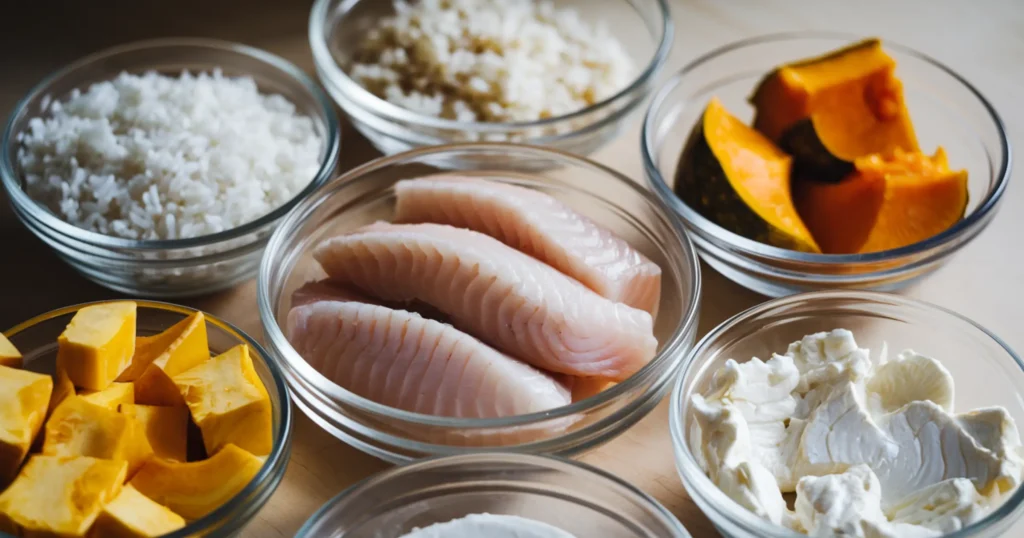
Lean Protein Sources
Protein provides essential amino acids without burdening the pancreas when chosen carefully:
- Skinless chicken breast: Extremely lean when boiled or baked without oil
- White fish: Cod, tilapia, and haddock offer easily digestible protein
- Extra-lean ground turkey: Look for 99% fat-free or prepare and drain carefully
- Egg whites: Provide protein without the fat found in yolks
- Low-fat cottage cheese: Offers protein with probiotics (use sparingly)
Our cottage cheese and rice formula demonstrates how even dairy can be incorporated safely when selected properly.
Digestible Carbohydrates
Carbohydrates provide energy without taxing the pancreas:
- White rice: Highly digestible, soothing to the digestive tract
- Sweet potatoes: Nutritious, fiber-rich, and easily digested when cooked thoroughly
- Regular potatoes: Well-tolerated by most dogs with pancreatitis
- Pumpkin: Supports digestion with beneficial fiber (not pie filling, plain only)
- Oatmeal: Plain, unsweetened variety can be tolerated by some dogs (use cautiously)
Beneficial Vegetables
Vegetables add nutrients and fiber with minimal fat:
- Carrots: Rich in beta-carotene and fiber
- Green beans: Low-calorie and nutritious
- Zucchini: High moisture content and easily digestible
- Peas: Good source of vegetable protein and fiber (use in moderation)
- Spinach: Packed with nutrients (cook thoroughly and use sparingly)
A well-balanced vegetarian option can incorporate several of these vegetables for variety.
Beneficial Supplements (Veterinarian-Approved)
Some supplements may benefit dogs with pancreatitis, but always consult your veterinarian before adding them:
- Fish oil: In very small, precisely measured doses for omega-3 fatty acids
- Probiotics: May help with overall digestive health
- Digestive enzymes: Sometimes recommended for pancreatic insufficiency
- Vitamin B complex: Often depleted during pancreatitis episodes
Food Preparation Guidelines for Pancreatitis Recipes
Proper preparation of homemade dog food for pancreatitis is just as important as ingredient selection.
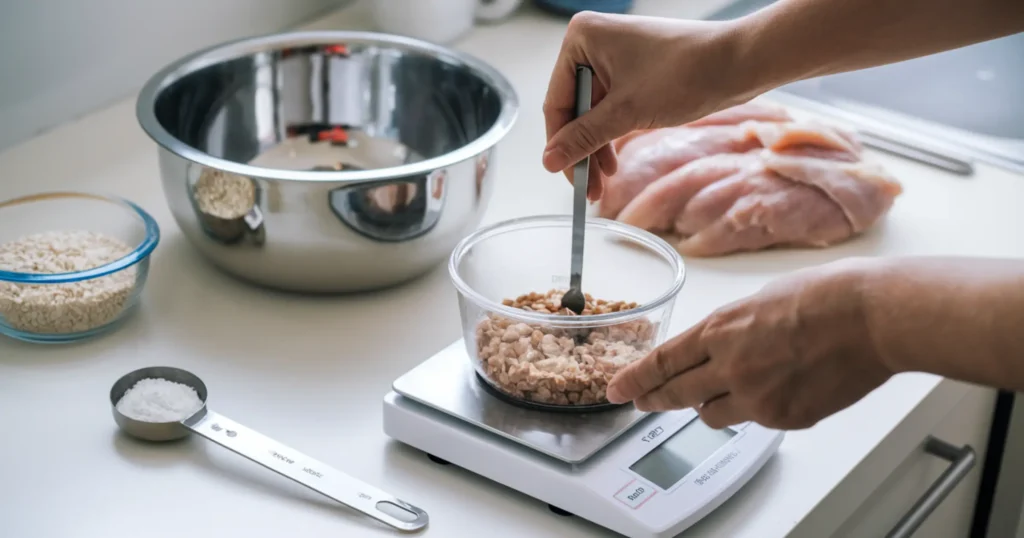
Cooking Methods
Cooking technique significantly impacts the final fat content:
- Boiling/poaching: Ideal for meats, as fat can be skimmed off
- Steaming: Excellent for vegetables, preserves nutrients
- Baking: Acceptable if no fat is added and drippings are discarded
- Avoid entirely: Frying, sautéing, roasting with oils
Measuring and Portion Control
Precision matters when preparing a diet for dogs with pancreatitis:
- Use a food scale: Measure ingredients by weight, not volume
- Calculate calories: Ensure appropriate energy intake
- Adjust portions: Based on weight, activity level, and recovery stage
- Monitor weight: Regularly weigh your dog to prevent unhealthy weight loss or gain
Food Safety and Storage
Homemade food requires careful handling:
- Cool completely: Before refrigerating or freezing
- Refrigerate: Keep portions for 3-4 days maximum
- Freeze: Individual portions for up to 3 months
- Thaw safely: In the refrigerator, not at room temperature
- Discard: Any food left uneaten after 20 minutes
Sample Recipe Approaches (Without Detailed Recipes)
While detailed recipes will be covered in dedicated articles, here’s a brief overview of the approaches we’ll explore:
Gentle Chicken Option
For acute recovery phases, a simple preparation focusing on skinless chicken breast and white rice forms the basis of an extremely low-fat, highly digestible meal. This represents the most basic starter diet for dogs with pancreatitis.
Turkey and Vegetable Blend
Incorporating extra-lean ground turkey with pumpkin and selected vegetables creates a nutrient-rich option for maintenance phases of pancreatitis management. This provides more diverse nutrition while maintaining low-fat parameters.
Digestive-Friendly Fish Preparation
White fish combined with sweet potatoes offers an excellent alternative protein source that’s particularly gentle on the digestive system. This option works well for dogs who may have protein sensitivities alongside pancreatitis.
Plant-Based Alternative
A thoughtfully formulated vegetarian option featuring carefully selected plant proteins, rice, and digestible vegetables can serve as an excellent rotation or temporary option during flare-ups when animal proteins might be too stimulating.
Cottage Cheese Variation
Incorporating small amounts of low-fat cottage cheese with rice and select vegetables provides a different protein source and beneficial probiotics when used appropriately. This option demonstrates how even dairy can be incorporated in a diet for dogs with pancreatitis when chosen carefully.
Transitioning to Homemade Pancreatitis Diets
Moving your dog to homemade food for dogs with pancreatitis requires a methodical approach.
Initial Transition Guidelines
Take these steps when beginning any new dietary regimen:
- Obtain veterinary approval: Before starting any homemade diet
- Start gradually: Begin with 25% new food, 75% previous diet
- Increase slowly: Adjust the ratio by about 10% every 2-3 days
- Monitor closely: Watch for any digestive upset or symptoms
- Be prepared to adjust: Modify the transition timeline as needed
Special Considerations During Acute Episodes
During active pancreatitis flares, special feeding protocols may be necessary:
- Initial fasting: Your veterinarian may recommend a brief fast (12-24 hours)
- Water access: Maintain access to fresh water unless otherwise directed
- Reintroduction: Begin with tiny amounts of bland food
- Hospital diet: Follow any specific dietary instructions from your veterinarian
- Prescription foods: Sometimes used initially before transitioning to homemade options
Nutritional Balance in Homemade Pancreatitis Diets
Creating nutritionally complete homemade dog food for pancreatitis requires attention to overall balance.
Essential Nutrient Considerations
Beyond fat restriction, ensure your dog receives:
- Complete protein: All essential amino acids
- Balanced minerals: Particularly calcium and phosphorus
- Essential fatty acids: Small amounts of omega-3s (as approved by your vet)
- Vitamins: From varied ingredients or supplements if needed
- Fiber: For digestive health and consistent stool quality
Working with Nutrition Professionals
Creating a truly balanced diet for dogs with pancreatitis often requires professional guidance:
- Veterinary nutritionist consultation: Highly recommended for long-term homemade diets
- Regular veterinary check-ups: To monitor health and nutritional status
- Bloodwork monitoring: To ensure organ function and nutritional adequacy
- Recipe adjustments: Based on your dog’s specific response and needs
Long-Term Management and Monitoring
Managing pancreatitis through diet is typically a lifelong commitment.
Signs of Dietary Success
Look for these positive indicators:
- Symptom resolution: No vomiting, diarrhea, or pain
- Energy improvement: Return to normal activity levels
- Stable weight: Appropriate weight maintenance
- Good stool quality: Consistent, well-formed bowel movements
- Normal bloodwork: Improved pancreatic enzyme levels
Warning Signs Requiring Attention
Be alert for these concerning signals:
- Return of symptoms: Vomiting, diarrhea, lethargy, or pain
- Excessive weight loss: Despite adequate caloric intake
- Ravenous hunger: Could indicate malabsorption
- Poor coat quality: May signal nutritional deficiencies
- Behavioral changes: Lethargy, irritability, or other personality shifts
When to Rotate Recipes
Varying homemade dog food for pancreatitis can provide nutritional benefits:
- Once stable: After 2-4 weeks on one recipe without issues
- Gradual introduction: Introduce new recipes slowly
- Monitor response: Watch carefully for any negative reactions
- Maintain consistency: Use similar fat levels between recipes
- Keep records: Note which recipes work best for your dog
Additional Supportive Care for Dogs with Pancreatitis
While diet forms the foundation of care, other factors support recovery and management.
Weight Management
Maintaining an ideal weight is crucial for dogs with pancreatitis:
- Regular weighing: Monitor weight weekly during recovery
- Body condition scoring: Learn to assess your dog’s body condition
- Caloric adjustments: Modify portions based on weight trends
- Exercise considerations: Appropriate activity for weight management
Medication Considerations
Some medications may interact with pancreatitis or its dietary management:
- Avoid steroids: When possible, as they can exacerbate pancreatitis
- Pancreatic enzymes: Sometimes prescribed for pancreatic insufficiency
- Anti-nausea medications: May be needed during flares
- Pain management: As directed by your veterinarian
Feeding Schedule Optimization
How you feed is nearly as important as what you feed:
- Consistent timing: Feed at the same times daily
- Appropriate environment: Quiet, stress-free feeding location
- Elevated dishes: May help some dogs with digestive comfort
- Slow-feeding methods: For dogs who eat too quickly
Hydration Support
For dogs with pancreatitis, proper hydration is especially crucial:
- Fresh water access: Always available, changed multiple times daily
- Moisture in food: Homemade diets can include the right amount of water content.
- Ice cubes: Can help encourage fluid intake in reluctant drinkers
- Monitoring: Watch for signs of dehydration (dry gums, lethargy, skin tenting)
Stress Reduction
Stress can exacerbate pancreatitis symptoms in some dogs:
- Consistent routine: Predictable daily schedule
- Quiet mealtimes: A Peaceful environment for eating
- Gentle exercise: Appropriate physical activity without overexertion
- Comfortable rest areas: Multiple soft bedding options in quiet locations
Special Considerations for Different Dogs

Adapting homemade food for dogs with pancreatitis to individual needs requires consideration of:
Age Factors
Different life stages may require recipe modifications:
- Senior dogs: May need softer textures and higher digestibility
- Young adults: Require careful caloric balance for activity levels
- Puppies: Rarely get pancreatitis, but need growth-appropriate nutrition if they do
Size Considerations
Dog size affects nutritional needs and feeding approaches:
- Small breeds: Often need more calories per pound, but are prone to pancreatitis
- Large breeds: May require specific mineral balances for joint health
- Giant breeds: Have special growth and maintenance requirements
Concurrent Health Conditions
Many dogs have multiple health concerns that affect dietary planning:
- Diabetes: Often occurs alongside pancreatitis, requiring coordinated management
- Kidney disease: May need protein modification alongside fat restriction
- Food allergies: May limit ingredient options
- Inflammatory bowel disease: Often requires a specialized dietary approach
Breed-Specific Risks
Some breeds have higher pancreatitis risk or specific nutritional concerns:
- Miniature Schnauzers: Genetically predisposed to pancreatitis and often have fat metabolism issues
- Yorkshire Terriers: Higher incidence of pancreatitis, and often have sensitive digestive systems
- Cocker Spaniels: Prone to pancreatitis and may have concurrent ear or skin conditions
- Miniature Poodles: have an increased risk of health issues that may necessitate lifelong dietary management.
Activity Level Adjustments
Your dog’s exercise needs impact dietary requirements:
- Working dogs: May need more calories while maintaining low fat percentages
- Senior or sedentary dogs: require fewer calories to prevent weight gain.
- Rehabilitating dogs: Need balanced nutrition to support healing without weight gain
- Seasonal adjustments: Activity levels may change with weather or seasonal routines
Key Takeaways: Homemade Dog Food for Pancreatitis
For quick reference, here are the essential points to remember about creating homemade dog food for pancreatitis:
- Fat restriction is critical: The most important dietary modification is limiting fat content to reduce pancreatic strain.
- Lean protein sources are essential: Choose skinless chicken breast, white fish, extra-lean ground turkey, and low-fat cottage cheese.
- Digestible carbohydrates form the base: White rice, sweet potatoes, pumpkin, and regular potatoes are well-tolerated options.
- Cooking methods matter: Boil, steam, or bake without added fats; never fry or sauté with oils.
- Portion control prevents recurrence: Carefully measure ingredients, divide into small, frequent meals, and monitor weight.
- Veterinary supervision is non-negotiable: Work with your veterinarian to ensure nutritional adequacy and monitor progress.
- Transition gradually: Make dietary changes slowly to prevent digestive upset.
- Food safety requires diligence: Proper storage, handling, and freshness are crucial for homemade diets.
- Individual adaptation is necessary: Each dog’s needs vary based on age, size, activity level, and concurrent conditions.
- Consistent dietary management over time: can greatly enhance the quality of life for dogs suffering from pancreatitis.
FAQs About Homemade Dog Food for Pancreatitis
Is homemade food better than prescription diets for dogs suffering from pancreatitis?
Both homemade and prescription diets can be effective for managing pancreatitis. The advantage of homemade dog food for pancreatitis is the ability to control exact ingredients and adjust for individual needs. However, prescription diets offer guaranteed nutritional balance and convenience. Many veterinarians recommend starting with a prescription diet during acute recovery, then potentially transitioning to carefully formulated homemade options for long-term management. It’s important to consult your veterinarian before making this decision. They can provide the guidance you need to ensure the best outcome for your pet.
How do I calculate the fat content in my homemade recipes?
Calculating fat content requires knowing the fat percentage of each ingredient and the total calories in your recipe. For precise calculations:
- Research the fat content of each ingredient (in grams)
- Multiply grams of fat by 9 to find calories from fat.
- Divide fat calories by total recipe calories
- Multiply by 100 to get a percentage
For most homemade recipes, aim for 10-15% of calories from fat. A veterinary nutritionist can help create properly balanced recipes appropriate for your dog’s specific needs.
Can I feed raw food to a dog with pancreatitis?
Raw diets are generally not recommended for dogs with pancreatitis for several reasons:
- Many raw diets are higher in fat
- Raw meat can contain bacterial contaminants, problematic for compromised immune systems
- Digestibility can be more challenging for dogs with pancreatic issues
- Temperature of food matters for digestive comfort
Most veterinarians recommend thoroughly cooked food for dogs with pancreatitis to maximize safety, digestibility, and fat control.
How long will my dog need a special diet for pancreatitis?
The duration of dietary management depends on the nature of your dog’s condition:
- Acute, single episode: May return to a normal (though moderate-fat) diet after 2-3 months
- Recurrent acute episodes: Will likely need permanent dietary management
- Chronic pancreatitis: Requires lifelong dietary modifications
Most dogs with a history of pancreatitis benefit from permanent dietary adjustments to prevent recurrence, especially breeds with a genetic predisposition to the condition.
Can treats be included in a pancreatitis diet?
Treats can be included for dogs with pancreatitis, but must be chosen carefully:
- Use small pieces of the same ingredients in your homemade food for dogs with pancreatitis (plain chicken, sweet potato, etc)
- Avoid commercial treats unless specifically formulated for low-fat diets
- Count treat calories as part of daily intake (treats should not exceed 10% of daily calories)
- Freeze-dried pure meat treats (non-fatty) can work well in minimal amounts
Many dogs appreciate ice cubes as treats, especially with a small amount of chicken broth (fat-free, low-sodium) frozen inside.
How do I know if my homemade diet is working?
Positive indicators that your diet for dogs with pancreatitis is effective include:
- Resolution of symptoms (no vomiting, abdominal pain, or diarrhea)
- Improved energy and activity levels
- Maintenance of appropriate weight
- Normal appetite
- Good coat quality
- Consistent, well-formed stools
- Normal bloodwork results, particularly pancreatic enzyme levels
To track development and verify improvement, routine veterinary examinations are necessary.
What if my dog refuses to eat the homemade pancreatitis diet?
If your dog refuses homemade dog food for pancreatitis:
- Serve the food at room temperature, not cold.
- Try slightly warming the food to enhance the aroma
- Start with very small portions offered frequently
- Use different approved protein sources to find preferences
- Ensure pain is adequately controlled (pain decreases appetite)
- Discuss appetite stimulants with your veterinarian if necessary
Consistency and patience are important; many dogs adjust to new diets within a few days.
Can supplements help dogs with pancreatitis?
Some supplements may benefit dogs with pancreatitis, but should only be used under veterinary guidance:
- Digestive enzymes: May help with nutrient absorption if pancreatic function is compromised
- Probiotics: Can support overall gut health during recovery
- B-complex vitamins: Often beneficial, as these can be depleted during illness
- Omega-3 fatty acids: In carefully controlled, veterinarian-approved amounts
Never add supplements to your dog’s regimen without consulting your veterinarian first.
Is it normal for my dog to lose weight on a pancreatitis diet?
Some initial weight loss may occur during acute pancreatitis recovery. However, a properly formulated homemade food for dogs with pancreatitis should maintain a healthy weight once the condition stabilizes. If your dog continues losing weight:
- Ensure caloric intake is adequate for size and activity level
- Check that the diet is sufficiently digestible
- Rule out concurrent conditions affecting weight
- Consider adding more calories from non-fat sources
- Consult your veterinarian for assessment
Healthy weight maintenance is an important goal of pancreatitis management.

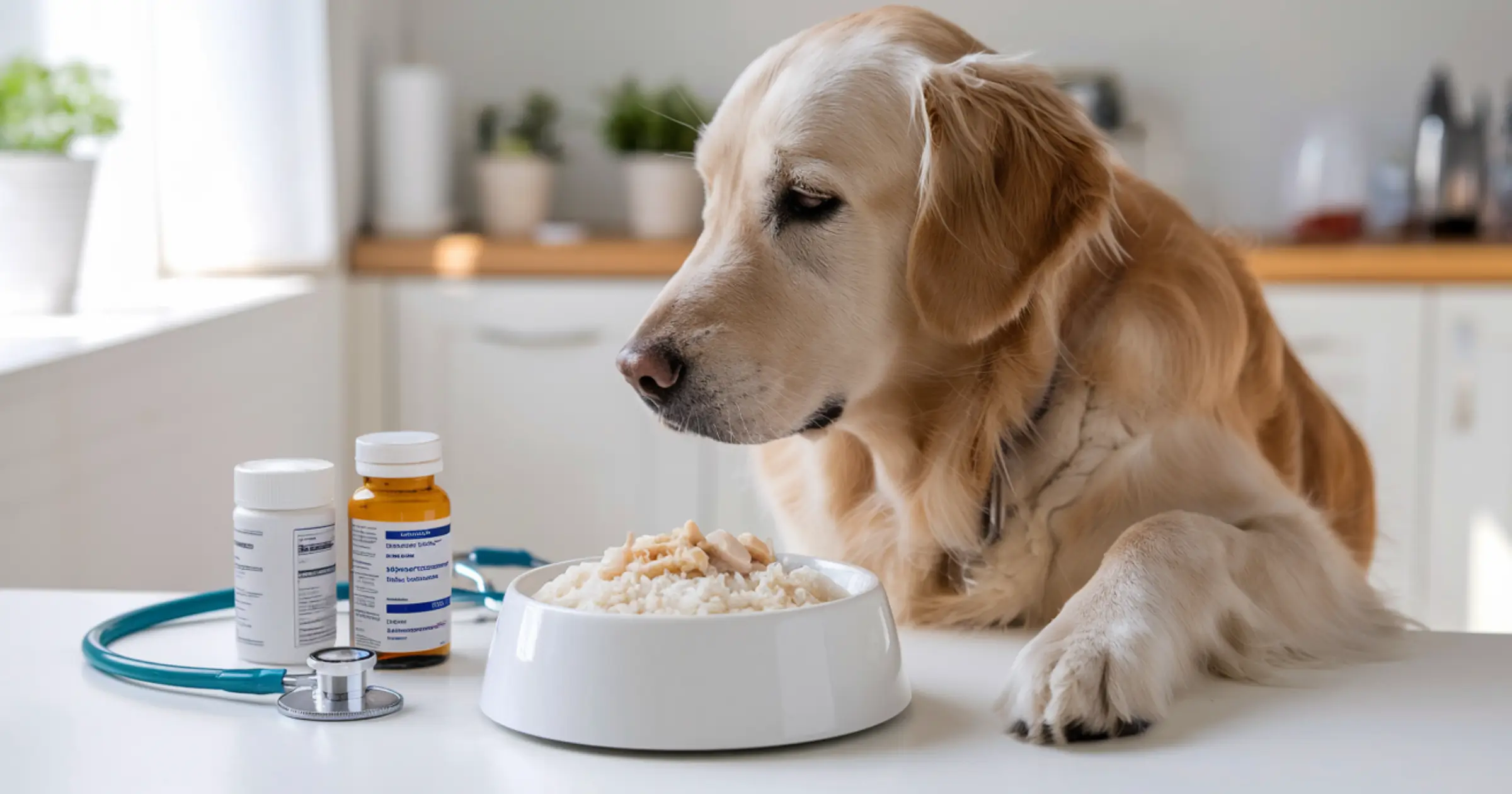
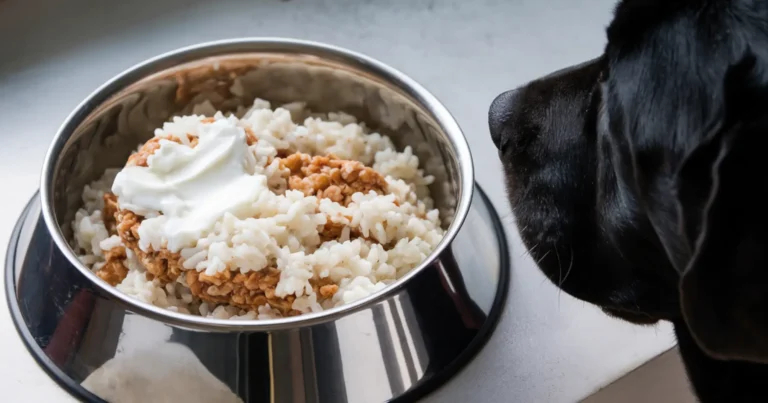
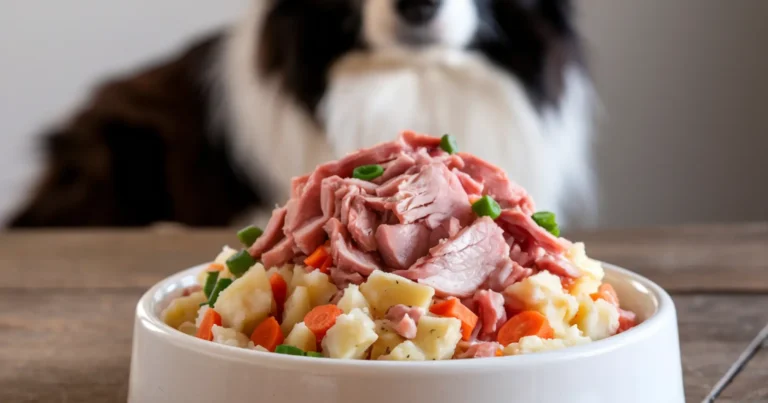
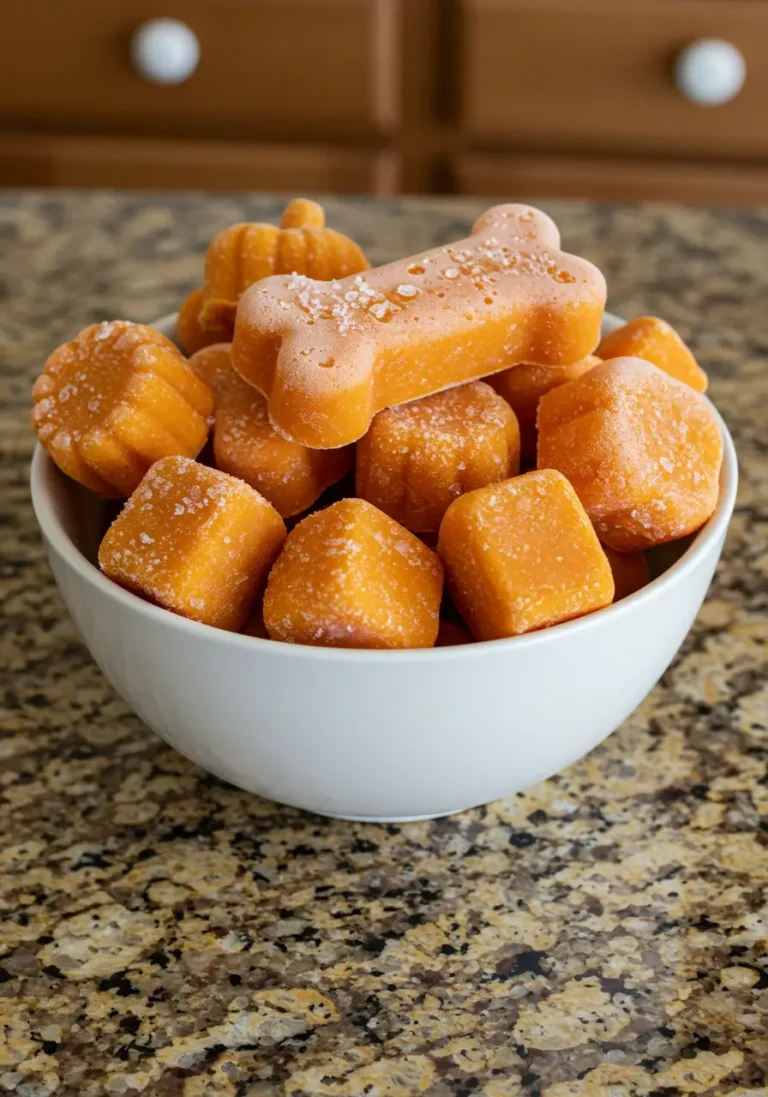
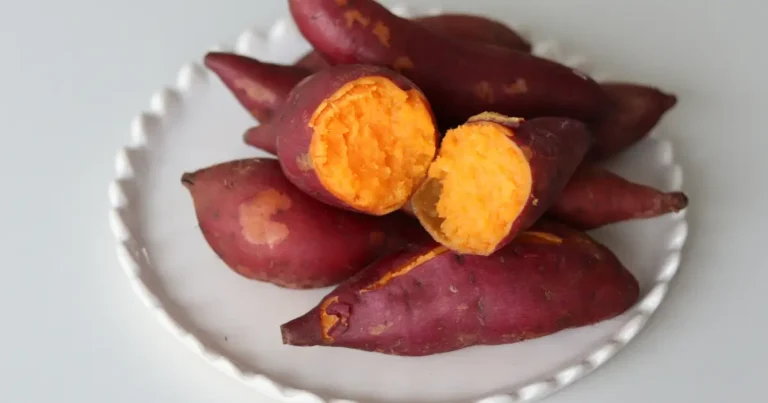
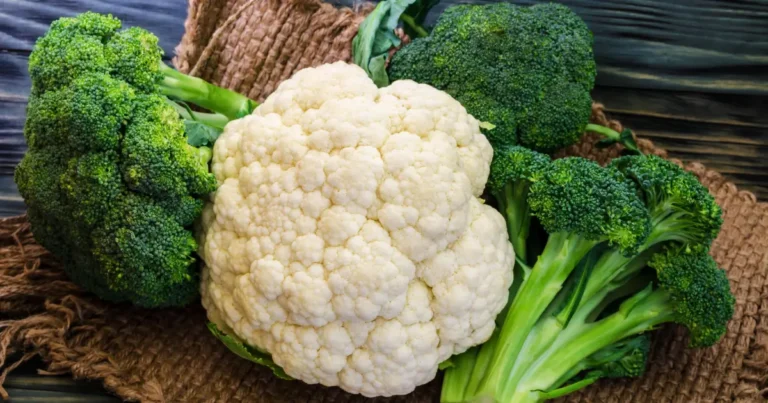
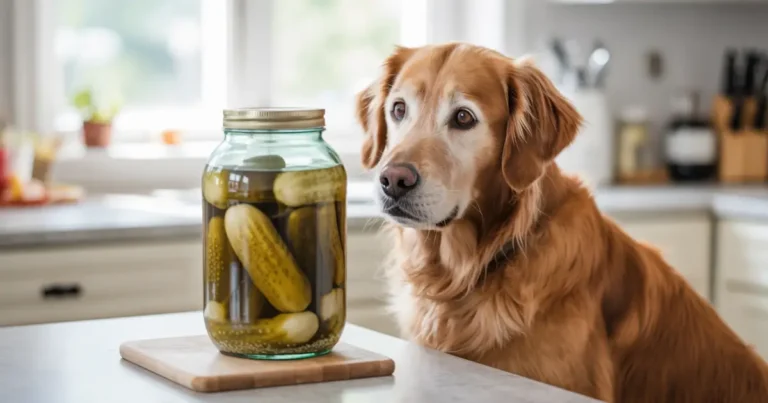
I do not even know the way I ended up right here, however I assumed this put
up was once good. I do not know who you are however certainly you are
going to a famous blogger should you aren’t already.
Cheers!